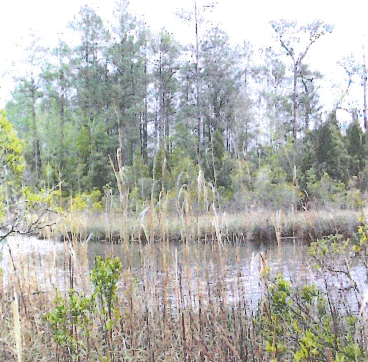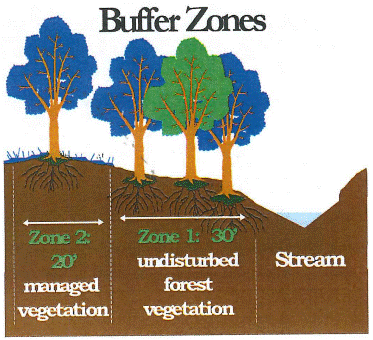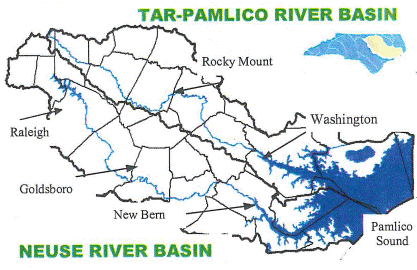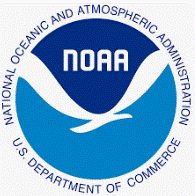Understanding Buffer Rules and your Future Property Purchase (for Prospective Landowners)
Click here to view Johnston County's Riparian Buffer Ordinance

What are Riparian Buffers?
The word riparian means next to the banks of streams, rivers, lakes, estuaries, or other waters. A riparian buffer is a strip of forested or vegetated land bordering a body of water and is important in protecting water quality. A buffer may be any combination of shrubs, herbs, and native grasses, but the best vegetation for stabilizing streambanks and removing nutrients is deep-rooted, woody vegetation.
Riparian buffers are managed as two zones. The zone closest to the water provides streambank and shoreline protection. The outer zone slows and spreads out the flow of water coming from the land, trapping sediment and other pollutants.

Riparian Buffer Protection

The Division of Water Quality's Buffer Protection Rule is a part of the state's nutrient reduction strategy for the Neuse and Tar-Pamlico River Basins. The rule requires protection of existing vegetation in the first 50 feet of riparian area within these basins.
What does it mean to protect the buffer?
The first 30 feet from the waterbody should be essentially undisturbed. The next 20 feet should be vegetated; however, certain uses are allowed.
Benefits of Riparian Buffers
Riparian buffers:
- Protect property from eroding away
- Provide flood control
- Absorb noise from waterfront activity
- Provide privacy
- Take up nutrients
- Filter sediment from runoff
- Control water temperature
- Provide wildlife food and habitat
- Provide recreational value such as fishing and and bird-watching
Is my Property Included?
Intermittent and perennial streams, lakes, ponds, and estuarine waters are protected by these rules.
If you are unsure whether this includes your property, you can obtain a copy of the county soil survey produced by the Natural Resources Conservation Service and a 1:24,000 scale topographic map prepared by the U.S. Geologic Survey.
If the surface water is indicated on one or the other source, then the buffer rules apply. The North Carolina Division of Water Quality will make the final determinations.
Contact your Local Soil and Water Conservation District for map assistance.
What Activities are Allowed?
You will want to read and understand the rule prior to beginning any activity within the buffer. The following are a few of the allowed activities in the rule.
- Fences, if no woody vegetation is removed
- One-time fertilizer application to establish replanted vegetation (ongoing fertilization is not allowed)
- Playground equipment
- Removal of poison ivy, poison oak, vines, and honeysuckle
- Planting vegetation to enhance the buffer
- Removal of trees that are dead, dying, or diseased. Must be verified by a registered forester.
- Removal of trees that are in danger of causing damage to existing structures or human life
- Limited pruning of forest vegetation as long as it doesn't compromise the health of the tree
For More Information:
For more information on the Neuse and Tar-Pamlico Buffer Rules, please contact the Division of Water Quality staff:
DENR Washington Regional Office
943 Washington Square Mall
Washington, NC 27889
252-946-6481
DENR Wilmington Regional Office
127 N Cardinal Drive Extension
Wilmington, NC 28405
910-796-7215
DENR Raleigh Regional Office
3800 Barrett Drive, Suite 101
Raleigh, NC 27699
919-571-4700
The rules can be viewed or downloaded from the North Carolina Environmental Quality's Division of Water Resources page at: https://www.deq.nc.gov/about/divisions/water-resources.
The Neuse and Tar-Pamlico Buffer Rules may not be the only regulations that apply to your property. For more information, you can contact the following agencies at the DENR Regional Offices:
Division of Water Quality
Division of Coastal Management
US Army Corp of Engineers



Information on this page was adapted from a brochure by the National Oceanic and Atmospheric Administration through the North Carolina Department of Natural Resources, Division of Water Quality, Coastal Nonpoint Source Program.
Related Links
- Homeowner Information
- Homebuilder Information
- General Information
- Riparian Buffers
Page last updated: April 11, 2025
